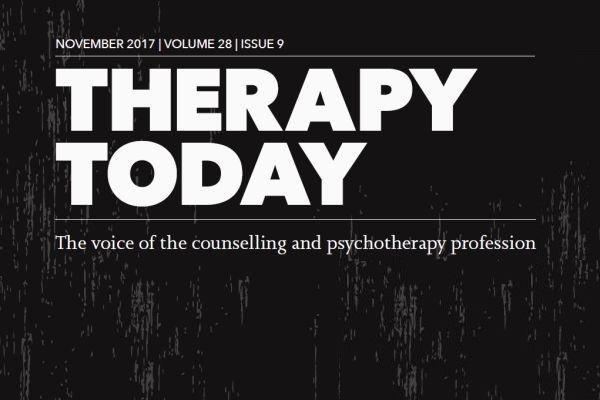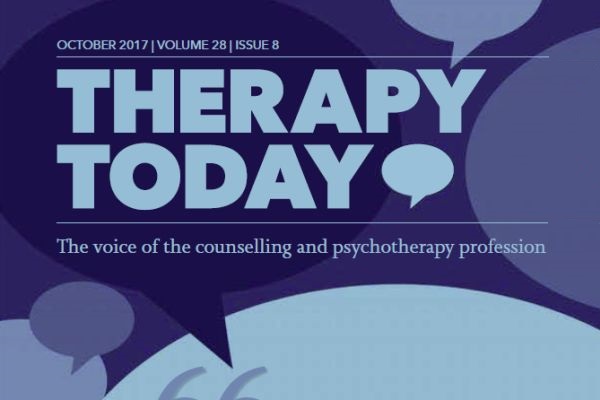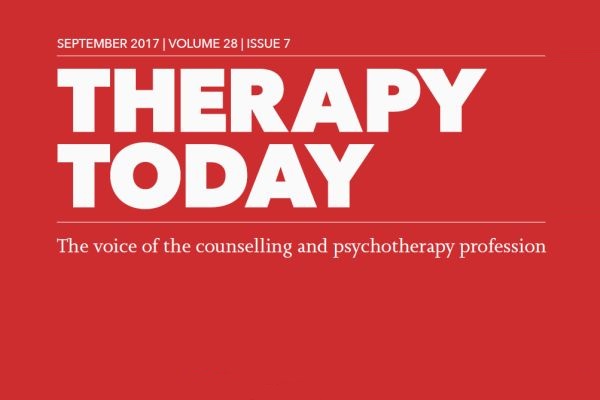How often do you work with issues involving a client’s gender and sexuality? Given that they are central to all our lives and at all ages, it has to be most days.
How well do you think you are equipped to deal with them?
Gender and sexuality are among the least well-covered topics in counselling and psychotherapy education and training, yet shrouded in lack of knowledge and misunderstanding. They are also very complex, and intersect with many other factors – age, class, race, culture and religion, as well as personal beliefs and experiences. It has taken a long time for modern medicine and UK law to recognise that difference does not mean disorder or dysfunction with respect to gender and sexual diversities. This is also true for the psy professions.
Last month, BACP, along with all the main psychotherapy and psychology professional bodies, took a further, significant step forward in recognising and righting this with the publication of a revised Memorandum of Understanding (MoU) that has been broadened to include gender identity.
The first MoU, published in January 2015, covered only sexual orientation, and was in response to the practice of conversion (or reparative) therapy – a faith-based model of counselling that sought to ‘cure’ homosexuality with psychological treatment, which the signatory bodies condemned as unethical and potentially harmful.
The revised MoU extends the ban on conversion therapy to include ‘any model or individual viewpoint that demonstrates an assumption that any sexual orientation or gender identity is inherently preferable to any other, and which attempts to bring about a change of sexual orientation or gender identity, or seeks to suppress an individual’s expression of sexual orientation or gender identity on that basis’.
It states that diversities in gender identity, like sexual orientation, are not ‘disorders’ requiring therapeutic intervention, and that counsellors and psychotherapists should ensure they are adequately trained and able to work without prejudice with all clients, regardless of how they identify themselves and their sexual practices and preferences.
Welcoming the MoU, Andrew Reeves, Chair of BACP, said: ‘We believe in a society where everyone can express their sexual orientation or gender identity. Every individual should have access to non-judgmental therapy, whatever their sexual orientation or gender identity, and it should be provided by an informed practitioner, committed to delivering skilled and evidence-based therapy.’ So far, so uncontroversial, surely? Did this even need spelling out when all the psy professions’ codes of practice make it clear that there is no place for personal prejudice in the counselling room?
Meg-John Barker, Senior Lecturer in Psychology at the Open University, therapist and activist-academic specialising in sex, gender and relationships, and author of the new BACP resource on Gender, Sexual and Relationship Diversity (GSRD), says yes: ‘Unfortunately, we have a deeply troubling record when it comes to the experiences of GSRD-marginalised people with straight, cisgender therapists. Virtually every client I see, who has experienced therapy before, has stories of counsellors trying to change their sexuality or gender, asking invasive and inappropriate questions, expecting the client to provide free education, and/or implicitly or explicitly suggesting that there is something pathological in the client’s gender, sexuality or relationships.’
There is, they* argue, a worrying vacuum of knowledge and confidence among psychotherapists and counsellors about gender identity, into which personal beliefs and prejudices can easily creep. ‘Even if you are trying not to see it as a problem, unless you have really reflected on your assumptions in this area and done some CPD training, you may well implicitly give the client that message. We also have to recognise that clients may present their GSRD identity or experience as a problem when it is the wider culture that is actually the problem, not them. It takes a decent amount of learning, reflection and experience on the part of the counsellor to get to the point where you can help clients navigate their gender, sexuality and relationships when the systems and structures around them are often toxic and oppressive in relation to them.’
Pamela Gawler-Wight agrees. A psychotherapist and director of training with BeeLeaf Institute for Contemporary Psychotherapy, she represented Pink Therapy on the working group that produced both MoUs. ‘The revised memorandum moves the discussion up to a level of universal human rights and generic ethical principles. We have all been brought up with the belief that binary gender identity is the natural, the only. It isn’t. We talk about self-actualisation as being everyone’s need and right. If we want our clients to reach a satisfactory outcome, we need to offer safe therapeutic spaces where they can self-declare, without being pressurised, and for that to be a therapeutic process,’ she says.
‘The MoU simply asks therapists to be research-informed, to get educated and to understand their generic code of ethics. Ninety-eight per cent of practitioners really want to practise well in this, but they are scared to make a mistake and don’t know where to get training and guidance. We all have limits to our practice, we have to admit that, and we all have a duty to get educated when there is a new paradigm of understanding in the world.’
Kris Black, integrative arts psychotherapist and counsellor, also represented Pink Therapy on the MoU group. Kris says the MoU is about social justice for marginalised groups: ‘Trans and non-binary people in the profession wanted trans to be included in this MoU because it is the right thing to do, because lives are at stake, because minority stress kills, and because there are far too many ill-informed practitioners of all persuasions out there doing damage to young people and adults in the name of therapy and counselling. The MoU may not be perfect, but it represents a start in terms of enabling practitioners to understand the damage – real, not imagined – that they do when they attempt to “cure” us.’
The key message of the MoU is simply underlining ethical practice, Kris says: ‘If you are not aware of this stuff, you are telling your clients they are not normal enough because they don’t confirm to your idea of what is normal. You are denying them their autonomy. We have a duty to educate ourselves about difference and diversity, and a legal responsibility to think about how we are perpetuating discrimination in our therapy practice. Every person who walks in through the door is not us. You can’t operate from the stance that you can only work with people like yourself.’
The MoU commits the signatory bodies to ensure that education and training standards and continuing professional development reflect its principles and equip practitioners to work with gender and sexuality issues. There has been criticism that little was done on this with respect for the first MoU. Kris says GSRD issues need to be embedded at all levels in the education and CPD of all counsellors and psychotherapists: this is not a bolt-on, niche area of practice. ‘Mainstream training needs to listen. This is part of the spectrum of human existence.’
The new GSRD resource, published last month, is a strong start in BACP’s work towards this, says Fiona Ballantine Dykes, BACP Head of Professional Standards. The current review of the Ethical Framework is also an opportunity to embed the MoU commitments in its best-practice principles. BACP is also reviewing its course accreditation standards: ‘We are able to set standards for what we expect from a BACP-accredited course on how it covers gender diversity. We can’t so easily influence other courses, but we can promulgate good practice,’ she says.
Exploration
Reaching agreement on the wording of the revised MoU has not been easy; the MoU has provoked criticism that it is both too prohibitive and too affirmative. There are concerns that practitioners may avoid the issue when clients are questioning their gender identity or sexual orientation, lest they be accused of practising reparative therapy.
The revised text states: ‘This [MoU] is not intended to deny, discourage or exclude those with uncertain feelings around sexuality or gender identity from seeking qualified and appropriate help...For people who are unhappy about their sexual orientation or their transgender status, there may be grounds for exploring therapeutic options to help them live more comfortably with it, reduce their distress and reach a greater degree of self-acceptance. Some people may benefit from the challenge of psychotherapy and counselling to help them manage dysphoria and to clarify their sense of themselves. Clients make healthy choices when they understand themselves better.’
Says Kris: ‘If someone says they want to explore their gender identity, there’s nothing in the MoU that shuts down that exploration. What the MoU is saying is that it’s not your agenda, it’s the client’s agenda that matters here.’
‘Of course, there is complexity here,’ says Meg-John. ‘When a client is culturally marginalised in relation to their GSRD, they may well implicitly or explicitly give the impression that they would like to change. This is where the concept of diversity is so important: normalising the fact that actually gender, sexuality and relationships exist on a spectrum, or multiple spectrums, rather than there being a better/normal or worse/abnormal place to be in relation to them.’
Meg-John hopes the new GSRD resource will be helpful here in explaining how counsellors might work with this diversity model. ‘Another vital point is that pretty much everyone struggles with mental health and emotional issues relating to their gender, sexuality and relationships, regardless of whether they are marginalised or not. Instead of regarding these areas as only being relevant to those who are considered outside of the norm, we need to shift to addressing them with all clients.’
Children and young people
Work with children and young people who are questioning their gender identity is a particularly sensitive area; psychotherapists may find themselves positioned between a child who is grappling with gender dysphoria and their distressed parents, who are struggling to understand, while staying mindful that the child’s mind, body and identity are still developing.
‘If a child came into your consulting room and said, “I am a panda”, you would say, “Hello Panda, tell me about being a panda”. The key issue is what is distressing that child; if I refuse to accept a child’s statement about themselves, I am ignoring that distress,’ says Pamela. ‘A little girl says, “I want to grow up and be a boy”. So you ask, “What is it about being a boy that’s so great?” “Because boys can be soldiers.” When you start talking to them about it, you find that they think girls aren’t allowed to be angry or physical. While we live in a gendered society, we are muddying the water. Gender expression is not simply about binary sex.’
Child and adolescent psychotherapist Jeanine Connor says counsellors tend to be nervous about working with young people who are questioning their gender identity. ‘I deal with it in the same way that I deal with anything. I am curious, I challenge, I question, I explore. It doesn’t matter whether it’s about gender or anything else. For some, it’s an “Am I?” question and they want to work that out with someone who isn’t going to be condemning or condoning. For others who are sure, it might be about how to deal with that in the wider world, at school or within their family. For others, it might be helping a family get a referral to a gender identity clinic.
‘Families don’t know where to go with this, even when they are supportive. They may have had a son for 15 years and now they have a daughter, and for them it’s mind-blowing. I do my best to acknowledge how difficult it can be for them to support their child while managing their own feelings of confusion and loss.’ She doesn’t usually work directly with parents, and she worries that there is very little help out there for them, other than what is offered to those being seen at gender identity clinics. ‘All I can do is acknowledge how difficult it is for them and tell them they might need their own support as well.’
Michelle Higgins is a school counsellor, working with children aged 11 to 16. She says gender and sexuality issues come up in her work all the time. ‘On the whole, the young people don’t have a problem with it. What they talk to me about is their difficulties with other people’s attitudes – their parents, teachers, people of other generations who are uncomfortable with it, who see it as “just a phase”, or unacceptable. When they come to talk to me, it’s not because they’re confused; it’s to figure things out: “I don’t think I’m heterosexual, but I don’t think I’m gay.” My role is to listen to that uncertainty. If they are sure, then I let them know that I know that.
‘What I hear in the room are their feelings of powerlessness, of being shut down, that their inner knowing is being dismissed, and the injustice of it. What I can do is work with them so they feel they have a little bit of power in this, so they can get their voice heard.’ Work outside the counselling room can be an important part of that, raising awareness within the whole school community, she says.
Michelle feels young people today are having to manage evermore starkly polarised cultural and social expectations of masculinity and femininity, alongside, paradoxically, this greater acceptance of gender and sexual fluidity. ‘Young women think that what it means to be a woman is to wear high heels and short skirts and lots of make-up, and for some girls this doesn’t reflect who they think they are – does that mean they are not a woman? And it’s the same for boys – what is it to be a man? Personally, I can understand how going down the route of gender reassignment might look to some of them as though it would solve everything. I believe that if schools and society in general were more accepting of young people exploring and expressing that trans journey, perhaps fewer would feel they needed to go all the way down the route of medication and reassignment.’
Watchful waiting
There are just eight NHS gender identity clinics in the UK, and one specialist Gender Identity Development Service (GIDS) for children and young people, run by the Tavistock & Portman NHS Foundation Trust, with clinics in London and Leeds. The service has received a big upsurge in referrals in recent years. In 2009/10 they had 967 referrals; in 2016/17 they had 2016. The largest rise is among girls aged 13–18. Of 1302 referrals received in April to September this year, 905 identified their gender as female, and 387 as male, and 1041 were in this age group.
The issue of trans children has featured regularly in the national print and broadcast media lately, often in sensationalised reports of very young children being ‘fast-tracked’ towards surgical gender reassignment, against their parents’ wishes.
Bernadette Wren, a consultant clinical psychologist based at the London clinic, says this is far from the case. Most referrals wait up to and over a year to be seen and, in most cases, after the initial assessment interviews, there will be a further long period of watchful waiting. During this, the child may take on their preferred gender identity, and may be prescribed hormone blockers, the effects of which are reversible. Cross-sex hormones – which will begin the physiological process of gender transition, but are partially reversible – will only be prescribed when they are 16, and they cannot progress to surgery until they are 18.
‘We don’t see ourselves moving to intervention as the main solution or treatment, even though this is something a lot of families and children expect,’ Bernadette says. ‘The state of knowledge is very patchy and we have an obligation to talk honestly to families about the effects – the impact on fertility, mood, growth and cognitive development – without being alarmist. We don’t have long-term data on the effects of blockers during adolescence.’
There is increasing pressure from young people and families to move earlier to medical intervention, says Bernadette. ‘Effectively, we have a gatekeeping role. The child is in great distress about their developing body, and the families hope that intervention will mitigate their distress to some degree, and the child will be able to continue with aspects of their life that have been put on hold. Early intervention makes sense in that respect. But we are aware that many young people, particularly in the younger age group, once they start on blockers, will stay on them, and continue on to cross-sex hormones at a later date. It’s hard psychologically for them to come off and let the body develop.
‘There is a lobby that says only a minority will regret it, and they have the right to make their own mistakes. But the NHS is a caring and paternalistic organisation; we don’t want to just hold their hand while teenagers make their own mistakes. That would be to sidestep that gatekeeping role.
‘Services like ours are often seen as either reparative or affirmative but I don’t accept that. We are offering these young people the tools to help them to think about this big life change. We aim to help the young person go on living a life while they work out what sort of person they are. What we don’t want is that they put their lives on hold until they have the body they want. Some people think we overemphasise the possibility that the young person might change their mind. We believe we should never lose sight of that possibility.’
The MoU can be downloaded from bit.ly/2hqmGc3
The BACP Gender, Sexual and Relationship Diversity resource is available at Good Practice in Action
* ‘They’ is Meg-John and Kris’s preferred pronoun.
Catherine Jackson is editor of Therapy Today.
More from Therapy Today

Burnout... the high cost of caring?
Free article: Burnout is an ever-present risk in the caring professions. Sally Brown talks to counsellors about their experiences, and how to avoid it. Therapy Today, November 2017

Ten reasons to feel good about being a counsellor today
Free article: At a time when we are dealing with cuts to both counselling services and training in universities, we can easily lose sight of how far we have come. Sally Brown offers 10 reasons to feel proud to be a counsellor today. Therapy Today, October 2017

What the doctor ordered
Free article: More and more people are taking prescribed antidepressant medication. But are the drugs helping or hindering? Sally Brown reports on the overlooked problem of prescribed-drug dependency. Therapy Today, September 2017
